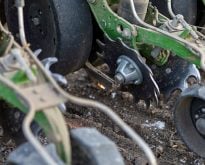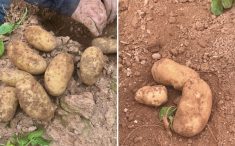Producers who applied their nitrogen in one pass this year at least minimized their application expenses. Those who opted for a split application and managed to co-ordinate it with well-timed rain perhaps gained more for their efforts.
Undoubtedly, however, both are questioning if their strategy was the right way to go this time.
And because of 2016’s dry growing season, this may be exactly the right year to push those questions as hard as you can.
Mike Strang, who cash crops with his father Keith and brother Geoff near Exeter, Ont., admits they certainly had their own questions about their split application strategy during the spring, even though they are variable-rate veterans.
Read Also

Agronomists share tips for evaluating new crop products and tech: Pt. 3
With new products, new production practices and new technology converging on the agriculture industry at a frenetic pace in recent…
Strang recalls his dad always sidedressing anhydrous ammonia. Then, when the younger Strang became part of the farm more than a decade ago, they added a rate controller, and then came zone and pre-sidedress nitrate testing as a basis for variable-rate application.
“Then, when we went to strip till, putting more nitrogen up front didn’t work so well because you were getting the pre-plant nitrogen in the soil test,” Strang explains. “So we looked for another system and (that) brought us to the AgLeader OptRx last year.”
With new technology in their arsenal, the application strategy this spring involved applying 50 pounds per acre of nitrogen at planting with their strip-till machine, then Y-dropping in another 60 pounds per acre around the six-leaf stage, followed by a variable-rate pass using OptRx sensing and Y-drop dispensing technology when the corn reached about five feet tall.
Last year, the OptRx/Y-drop combo seemed worth the investment and extra time spent in the driver’s seat. This year, when there wasn’t a cloud in the sky, it was harder to be so sure.
“We were really dry in June and I’m wondering if that first sidedress pass didn’t quite get into the corn crop,” Strang says. The crop never seemed to darken down, but stayed pale all the way through until the third nitrogen application.
Fortunately, after applying their late-season rate of anywhere from 60 to another 90 pounds per acre, Strang says they received two and three-quarter inches of rain. As far as he’s concerned, that was really critical timing.
“Later nitrogen available to the corn crop is probably better,” Strang now says. “I would even go later, but with our high clearance sprayer, if we get much taller than six feet we start breaking some of the corn.”
Yet he also knows that this might sound crazy to the neighbours.
Strang says they are one of only a few farmers in the neighbourhood using variable-rate application technology, and he can understand the appeal of one-pass strategies from a time management perspective. Still, most of the 1,000 acres of custom work he took on this year was done using his variable-rate setup and it hasn’t gone unnoticed that Hensall Co-op has outfitted three sprayers with Greenseekers.
Strang says they believe there are several good reasons to invest in the latest application devices.
“I didn’t like using anhydrous anymore. It almost killed me a couple times, and so I really wanted to move toward a 28 per cent liquid fertilizer. To get a decent-sized applicator, you’re looking at $40,000 and we bought a Y-drop system for less than $20,000,” Strang reports. “Year in and year out, with adequate rains, Y-drop versus a normal sidedress unit, yeah, there’s probably no difference. But for half the price of an applicator, I don’t see a downside to it.”
Strang says he also intuitively likes the idea of placing nitrogen right beside the corn rows so that it doesn’t take much rain before the plant gets access to it. Last year he thought he was being really smart by adding slow-release nitrogen to the mix and felt pretty good when the rains came. In hindsight, he should have gone in then and sidedressed anyway as soon as he started seeing yellow spots. This year’s lesson learned was not to trim the first application so much, so next year he’ll be back up to 80 or 100 pounds per acre pre-plant.
“We’re always learning,” Strang says. “But the benefit of splitting nitrogen is you can respond to weather challenges.”
Paul Raymer, of Practical Precision Inc. in Tavistock, Ont., says the Strang family really exemplifies the type of farm now moving to a split-nitrogen strategy. As one of the first companies to offer the GreenSeeker system to Ontario’s corn growers, he’s had the opportunity to observe early adopters of optical imaging share similar characteristics. Typically, they do belong to the younger generation of farmers and they show no fear of managing new technology. They also have a mindset that is more future focused and less inclined toward repeating what has worked in the past.
Raymer recalls how, in the early years, many farmers genuinely could not accept the concept that corn was capable of consuming nitrogen after the knee-high stage. So he also believes adopters of this technology are more comfortable with scientific literature related to plant physiology and nutrient uptake.
“It’s been a culture shift,” Raymer summarizes. “Probably one of the big momentum drivers to this split nitrogen movement has been the cost of inputs.”
When he first started in the business, Raymer says nitrogen prices were through the roof and interest in the product was very high. More recently, nitrogen has been fairly decently priced and, for a number of farmers out there, it’s just simpler to put a little extra on. The only thing he thinks will influence those individuals to stop this practice is another price spike or regulation, something he’s convinced is only a matter of time.
“Then there are the farmers looking at every dollar,” Raymer says. “Maybe they have limited acres. They want to maximize the productivity of every acre, as much as they can.”
Quite often, he says, they’ve observed some of the best results on highly manured ground. Since the technology was originally designed for conservation purposes by Oklahoma State University, it stands to reason that it’s well suited to identifying manure application inconsistencies. And although it’s not a silver bullet, Raymer says that on over 80 per cent of the fields the technology has more than paid for itself in either nitrogen savings or yield gains.
“We want to chase conservation, I think that’s good stewardship, and trying to leverage from what we gain naturally,” Raymer says. “But we may not pick up on what we’re really generating naturally until it exceeds the height capacity of our traditional nitrogen applicators.”
Raymer encourages growers to picture the growing life of a corn plant as having all the years of a human life compressed into one. “As soon as it gets into its adolescent years, its appetite is just going through the roof.” If that plant gets short-changed, it will never grow up to achieve its maximum potential, so identifying potential deficiencies and amending those properly with a little spoonfed nitrogen at this time, makes a lot of sense to him. “We’re really trying to maximize for the inputs that we’re putting into this somewhat expensive crop to grow,” Raymer says. “If nitrogen was stable in the soil, we wouldn’t be having this conversation right now.”
Echoing the very same sentiments is Paul Hermans, an agronomist for DuPont Pioneer in the eastern Ontario and Quebec area. However, the apparent behaviour of nitrogen in soils located outside of Ontario’s dominant corn growing region adds a twist to these ongoing conversations. He offers some recent Ontario Soil and Crop Improvement Association Y-drop trials, which were undertaken by the Ottawa, Lanark and Dundas chapters last year to evaluate split rates and timing, and which failed to produce any significant results in those areas.
“Conversely, in southern Ontario, at Pioneer we did some Y-drop trials and they got a bigger response,” he says. Hermans says too that he has found eastern Ontario soils tend to be able to cook up more nitrogen somehow, most likely out of the soil types and their organic matter. “In general I think we can produce more nitrogen out of our soils, so what happens there doesn’t always hold true for eastern Ontario,” he offers.
Which isn’t to suggest the new split nitrogen mindset is only being adopted in the southwest. Raymer says he’s seeing more and more farmers applying 60 to 70 per cent of their nitrogen as pre-plant broadcast, or broadcasting and putting some nitrogen through the planter, and then coming back to sidedress. He also believes relying on soil nitrate tests is now common practice.
To Raymer, it’s clear. If you aren’t actively looking for improvements to your nitrogen application strategy, he says, you’re leaving money on the table.
This article first appeared in the September 2016 issue of the Corn Guide.
















